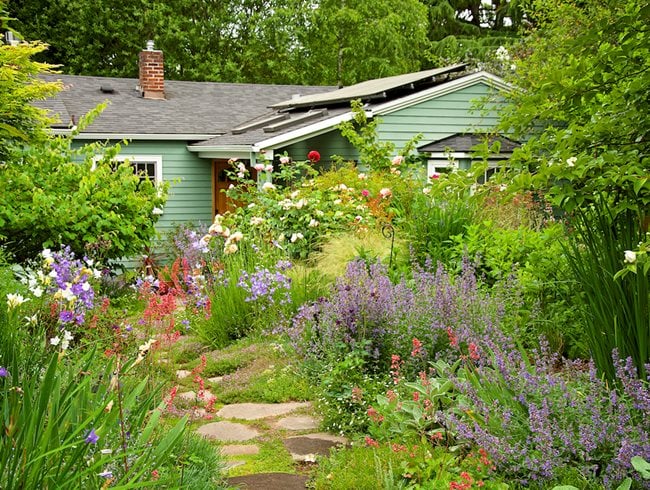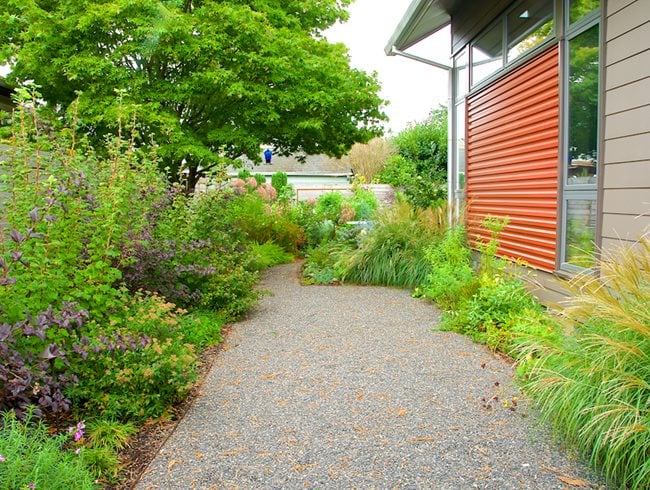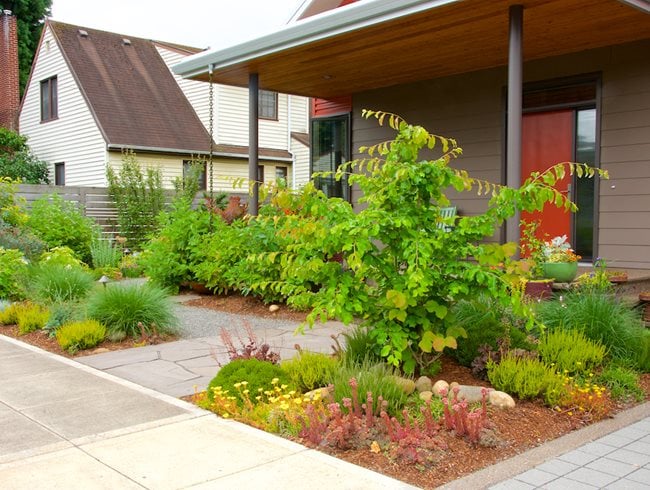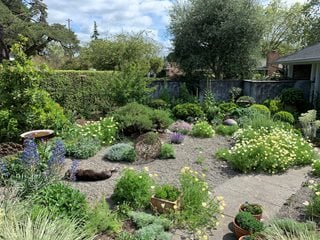Drought-Tolerant Landscaping Ideas
Create a waterwise landscape to reduce usage and cut down on your water bill Published 6/21/2022Drought-tolerant landscaping is not just for arid climates. Water conservation has become a bigger issue in recent years due to increased demand and expense. Climate change has contributed to the problem, with more regions experiencing intermittent or long-term droughts.
Creating landscapes that use less water, also known as xeriscaping, is becoming more common and imperative. Some communities have instituted restrictions on water use and the type of plants that can be grown. Whether you live in the desert or a climate that receives more rainfall, there are many ways you can reduce usage or conserve water in your yard. Here are some tips and ideas to get you started.
DROUGHT TOLERANT VS. DROUGHT RESISTANT
Though these terms are used interchangeably, there is a difference. Drought-tolerant landscaping utilizes plants that have adapted through evolution to thrive with minimal water. These include cacti and other desert plants. Drought-resistant landscaping involves using plants that can survive extended periods of dry weather, but do best with moderate or regular water. These include prairie plants such as coneflower, blazing star, and black-eyed Susan, along with other regional native trees, shrubs, and perennials.
DROUGHT-TOLERANT LANDSCAPING CONSIDERATIONS
Here are some factors to consider with drought-tolerant landscaping:
Climate.
Do you live in a hot dry climate? Or a climate that is cold and wet? A combination of both, depending on the season? Determine your USDA zone and average annual rainfall, which will help you choose what plants will work best in your area.
Soil.
What kind of soil do you have? Sand, clay, rock, or loam? Some soils allow water to drain quickly, while others retain moisture. While some drought-resistant plants prefer rich soil that’s amended with compost or other organic matter, others such as cacti and succulents prefer leaner soil. Good drainage is essential. See more on garden soil.
Light.
Full sun will make an area hotter, causing water to evaporate more quickly. Areas with partial or full shade will be cooler, staying wetter for longer.
Humidity.
Evaporation occurs more quickly in deserts and other regions with low air humidity, causing soil to dry out faster. For rainy humid climates, evaporation is slower. Some regions experience cool wet winters and warm dry summers, a mixed humidity climate best described as Mediterranean.
HOW TO CREATE A DROUGHT-TOLERANT LANDSCAPE
Evaluate your site.
Consider environmental factors such as light, soil, temperature, and humidity to determine what plants would be suitable for your landscape. Observe how the light falls in different seasons. There will be different conditions occurring in different parts of the yard, with dry, wetter, and transitional zones.
Draw up a plan.
Look to online and local sources for inspiration and create a rough sketch. For a more elaborate plan, or for difficult sites such as a slope, you may want to hire a landscape design professional.
Amend soil.
Depending on what you are planting, you may want to amend your soil. Amended soil retains moisture better and captures rainwater, while poor compacted soil allows water to run off the surface. Use organic matter such as compost, decomposed leaves, manure, or a combination. You may wish to add perlite, vermiculite, or lava rock (to help with aeration at the root zone) if planting cactus or succulents, but best to plant these in a mounded area.
Choose drought-resistant or drought-tolerant plants.
Select plants that require less water such as natives, sedums, succulents, and ornamental grasses. Natives have an added bonus of attracting local pollinators and birds to your garden. Plants with gray or silver foliage such as lamb’s ear, Russian sage, lavender, and santolina are more drought tolerant. Non-native ornamental plants from Australia, South Africa, and the Mediterranean use less water. Make sure non-natives are not invasive in your area. See more drought resistant plants.
*Note: All plants need to establish for at least two years before they will start to need less water; trees and large shrubs will take longer.
Group plants with similar water needs.
Assess the water needs of each variety and group plants together that have similar needs. This will help conserve water, and plants will be healthier because they are less likely to be over or underwatered.
Place plants closer together.
Beds that are more densely planted shade the soil, which reduces water evaporation. This also helps to suppress weeds, which can take moisture out of the soil.
Plant trees.
Create a shade canopy with trees that will cool your yard and home, act as a windbreak, and reduce water evaporation.
WATER SAVING IDEAS
There are many ways to save on your water bill. Here’s how:
Reduce or eliminate your lawn.
Green turf lawns take a lot of water and other resources to maintain. You don’t have to get rid of all of your lawn, but you can create drought-resistant garden beds in part of your yard. Some turf grasses require less water, fertilizer, and mowing. Groundcovers such as dead nettle, creeping thyme, and sedums can be substituted for a traditional lawn to control runoff and reduce water evaporation. See more eco-friendly lawn alternatives.
Use native plants.
Varieties that grow endemically to your area are adapted to your climate and growing conditions. These plants will need little supplemental water once established. Natives require little or no fertilizer and are more resistant to pests and diseases. Learn more about how to use native plants in your landscape.
Add permeable hardscape and outdoor rooms.
Create pathways or transition areas with permeable pavers or gravel to allow water to percolate into the ground rather than running off. Add a patio, deck, and other outdoor living spaces or garden rooms to reduce the amount of planted areas.

Rain barrels or cisterns collect water from gutter downspouts that can be used to water garden beds. Photo by: JuneJ / Shutterstock.
Plant a curbside strip.
The area between your curb and sidewalk is sometimes referred to as a “hell strip” for its reputation as a hot, inhospitable place. Creating a dry garden with drought-tolerant plants can help stem water loss, reduce maintenance, and control soil erosion.
Collect rainwater.
To conserve water, install rain barrels or a cistern to collect water from gutter downspouts that can be used later on to water garden beds.
Create a rain garden.
Add one or more rain gardens around your yard to capture water, reduce runoff, and conserve water. Find out more about how to create a rain garden.
Construct a water-efficient slope.
Add tiers to slopes to help stem erosion and control rainwater runoff. Place the most drought-resistant plants at the top of a slope where water drains more quickly, with plants that like the most water at the bottom, where water will collect after it rains. Find more on hillside landscaping.
MAINTENANCE
Water wisely.
The way you water your plants can reduce your water usage.
- Use drip irrigation or soaker hoses in beds to deliver water to plant roots, which is more efficient and reduces evaporation. You can install irrigation systems yourself or hire a professional. Learn more about irrigation systems.
- For containers, use a watering wand to direct water around the base of plants rather than spraying from overhead.
- Water early or late in the day when temperatures are cooler to reduce evaporation.
- Irrigate plants more deeply and less frequently, which will encourage roots to grow deeper into the soil, requiring less water.
- Don’t overwater plants that are adapted to dry conditions, as they can develop root rot or other problems.
- For more: How to Water Your Summer Garden
Mulch.
Add a layer of mulch around plants to retain moisture, cool the soil, and suppress weeds. Organic mulch includes compost, bark, or wood chips. Use gravel as a mulch in rock gardens or hell strips. Plant ground covers as a living mulch.
Weed.
Keep out thirsty weeds that will compete with garden plants for water.

Join us for our next webinar!
From Plan to Planting: Designing a Garden for Every Season, with Rebecca Sweet
May 15, 2025
DROUGHT TOLERANT GARDEN IDEAS
Here are some ideas on how to xeriscape your yard:
- Adorn a curbside strip with low-maintenance water-wise plantings.
- Create a rock garden and plant with sedums, succulents, and other drought-tolerant plants such as ice plant, sea thrift, sedges, and creeping phlox.
- Replace a thirsty lawn with low-maintenance plants that are native to your region.
- Redirect your gutter downspouts and add one or more rain gardens nearby to capture the water. A rain garden can act as a focal point in the landscape.
- Use permeable pavers and gravel for pathways that will allow water to seep into the ground rather than running off.
- Plant a slope with drought-tolerant shrubs, perennials, and ground cover plants to help retain water and stem erosion.
- Edge a patio or deck with drought-tolerant trees, shrubs, and perennials to provide shade, privacy, and color.
- Plant a drought-resistant hedge along a property line for privacy, using shrubs such as boxwood, Indian hawthorn, beauty bush, or viburnum.

A mix of native and non-native ornamental plantings benefits wildlife in this drought tolerant meadow garden. Gardeners: Jay Withgott and Susan Masta. Photo: Janet Loughrey.

A permeable gravel pathway was made wide enough to comfortably accommodates a wheelbarrow to haul mulch or compost from the front yard to the back yard. Gardener: Virginia Malone. Designer: Marina Wynton. Photo: Janet Loughrey.

Richly layered plantings of ornamental grasses, perennials, and succulents outline the boardwalk and gravel path that lead from the house down the backyard slope. Blue chalksticks complements repeating peach-apricot highlights of Kniphofia (center) and Cordyline (far left). Designer: Debora Carl. Photo by: Richard Bloom.

Permeable pavers and gravel comprise pathways, while water-wise plantings replace a water-thirsty lawn in this front yard garden. Gardener: Virginia Malone. Designer: Marina Wynton. Photo: Janet Loughrey.

This steep back yard hillside was stabilized with tiers that help stem erosion and control rainwater runoff. Gardener: Nancy Plumlee. Designer: Lori Scott. Photo: Janet Loughrey.

Horticulturist Denise Kelly's gravel garden uses 2 inches of compacted base rock with 1 to 2 inches of smaller gravel on top, for a fully permeable surface. Photo by: Denise Kelly. (See more of this garden.)

This biostream at Scott Arboretum, Swarthmore College, collects excess rainwater, slowly filtering and releasing it into the landscape. Photo: Rob Cardillo.





